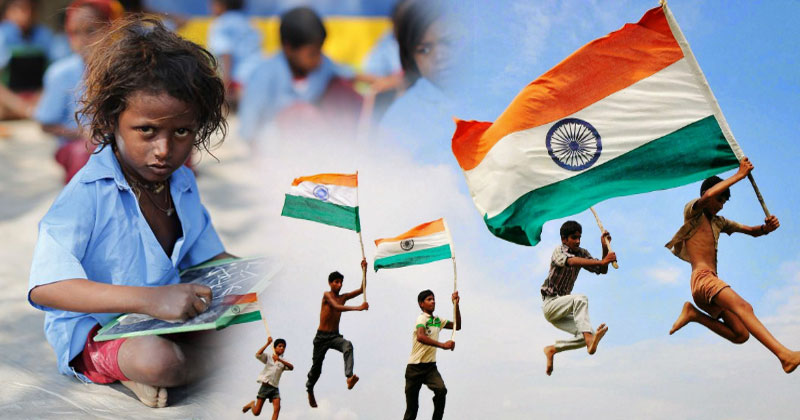
HAPPY INDEPENDENCE DAY!!!
Since independence in 1947, India has come a long way in terms of its literacy rate. With more universities and educational institutions, Indian students have a much better infrastructure for learning today. This piece tracks India’s progress in the education sector since its Independence.
Did You Know?
In ancient India, the ‘gurukul’ system was practiced. In this system, all the students lived under the same roof with their ‘guru’ (teacher), irrespective of their social standards, and followed a strict routine that was devoid of any pleasure or entertainment.
India, a culturally rich and diverse country, is one of the fastest growing economies with a potential for a bright future. Ruled by the British Raj for almost 100 years, India finally gained freedom on August 15th, 1947. As such, a lot of laws and systems in India are influenced by the British system, and the education system is no exception to it.
India, before independence, was divided on the lines of the caste system. Even today, there is a lot of caste discrimination prevalent. Moreover, only the elite were allowed to learn in older times, and those who performed menial jobs had no education. Predominantly being an agricultural country, most of the population is settled in rural areas. However, the education system in urban areas is much better. The efforts of the government has brought about a sea change in the scenario, as compared to earlier times.
Let’s check out the development of the education system in India after independence, with the help of some statistics and information about the government’s initiatives.
The Literacy Rate in India: 1951 to 2011
| Year | % of Literates | ||
| Total | Male | Female | |
| 1951 | 18.33 | 27.16 | 8.86 |
| 1961 | 28.30 | 40.40 | 15.35 |
| 1971 | 34.45 | 45.96 | 21.97 |
| 1981 | 43.57 | 56.38 | 29.76 |
| 1991 | 52.21 | 64.13 | 39.29 |
| 2001 | 64.83 | 75.26 | 63.67 |
| 2011 | 74.04 | 82.14 | 65.46 |
Note that, since 1991, only those above the age of seven years are classified as literate or illiterate.
Literacy Performance of States As Per 2011 Census
Highest Performing States
Kerala: 93.91%
Lakshadweep: 92.28%
Mizoram: 91.58%
Lowest Performing States
Bihar: 63.82%
Arunachal Pradesh: 66.95%
Rajasthan: 67.06 %
Conclusion: These statistics indicate that, since 1947, India has been making steady progress. Moreover, there is a large disparity in the literacy rates between different states, and also between both genders.
Latest News on the Block
According to the latest National Sample Survey Office (NSSO) survey, released on June 30th, 2015, based on a small sample consisting of 4,577 villages and 3,720 urban blocks, conducted during January to June 2014, as a part of the survey on ‘Social Consumption: Education’ ?
The literacy rate in India is 75% (for citizens above 7 years of age), with urban areas having 86%, and rural areas having 71% literacy rate.
Initiatives Taken by the Government for the Development of Education
- Sarva Shiksha Abhiyan (SSA) for children from 6 to 14 years old was launched in 2000-2001, to impart compulsory elementary education to all. The SSA program aims at ensuring availability of schools, infrastructure, especially in the rural areas, with special focus on girl-students.
- Saakshar Bharat Mission is an initiative by the Government of India, which imparts education to adults who do not have formal education. The ‘National Literacy Mission’, one of the programs of the mission, targets adults in the age group of 15 – 35 years.
- Mid-Day Meal Scheme: This scheme was introduced to increase the number of students attending school, and to provide nutrition to them at a nominal rate, in government-aided institutions.
- India’s traditional family system places boys at a higher place than girls. Hence, during the pre-independence period, there were very less women who were educated. However, as a result of the government’s efforts, there has been a large improvement in this regard. The ‘Mahila Samakhya Programme’ was launched in 1989 with an aim at giving quality education to women, that can boost their confidence, and enable them to make valuable contributions to the Indian economy.
Development of Physical Education
- The ‘Central Advisory Board of Physical Education and Recreation’ was set up in 1950 to promote physical education in schools, and also train teachers.
- The National Discipline Scheme was started in July 1954 to impart disciplinarian training, and instill in the minds of students the feeling of serving the nation.
- ‘Physical Education’ is a compulsory subject for students up to class X.
Governing Authorities
- The National Council of Educational Research and Training (NCERT) and State Council of Educational Research and Training (SCERT) is responsible for the development of the education system on a national and state level, respectively.
- University Grants Commission (UGC): In India, the UGC has been conferred the right to disburse grants to universities and colleges, and also act as a regulator for university education. It was formally established in November 1956.
- All these trends show, that despite considerable improvement, India has a potential to do much better. There are many who do not complete secondary education, especially in rural areas. Poverty and a huge population are also the contributing factors for India’s low literacy rate. Yet, with efforts from both, the citizens and the government, things are looking good and set to improve even further.

Post Your Comments